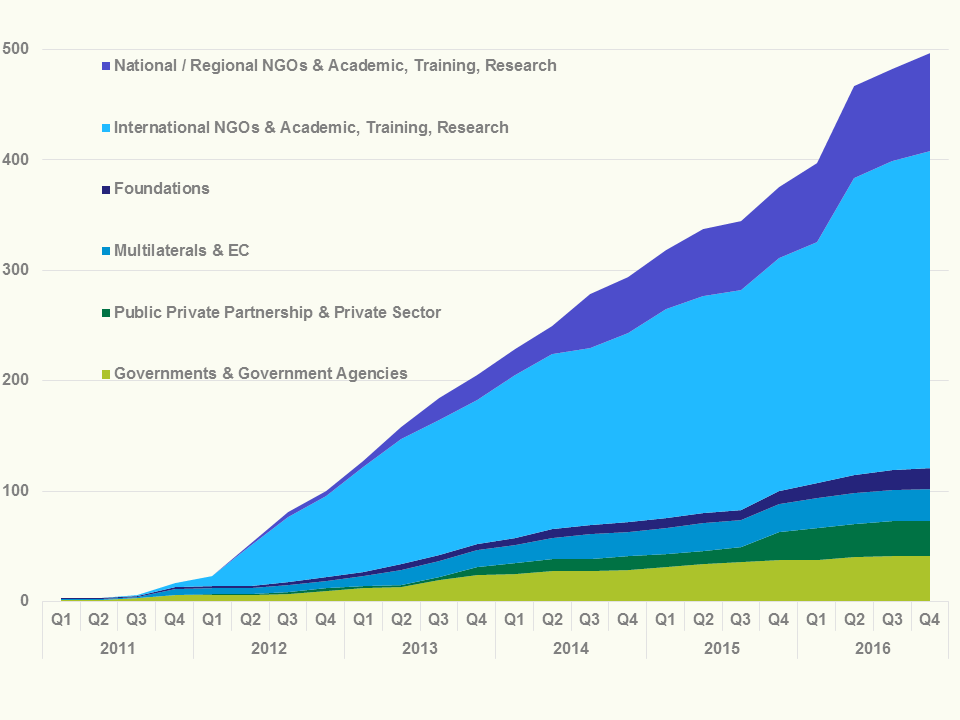HLM2 Briefing: IATI’s role in achieving effective development
IATI has published a briefing ahead of the 2nd High Level Meeting for the Global Partnership for Effective Development Co-operation (HLM2) next week (28 November- 3 December). Download ‘HLM2 Briefing: IATI’s role in achieving effective development‘ to gain all you need to know about IATI’s role in the GPEDC.
How does IATI help achieve development cooperation effectiveness?
IATI aims to make information about development and humanitarian resources easier to access, use, and understand. Organisations publish information on their spending to the standard set by IATI and this data is available, open and free to anyone in the world with internet access.
Supporting developing country governments: The IATI Standard meets the demand from developing country governments for timely, comprehensive and forward-looking information on external resources to better inform their decision making.
- Better planning: IATI allow donors to share aid budgets several years in advance, so developing country governments are able to better plan for the future.
- Up-to-date information: funds can be reported quarterly, monthly and even daily, which can be crucial in a humanitarian emergency
- Providing the bigger picture: IATI allows different types of development resources to be recorded. For example, investments from Development Finance Institutions (DFIs).
- Results can be captured: Organisations can publish data on the impact that development activities make. For example it allows for reporting on the post-2015 Sustainable Development Goals.
- Information is comparable: Different organisations publish data into our common format, allowing users to easily compare information that was previously published in different ways.
IATI also helps provide citizens, journalists, CSOs, politicians and others with the information required for holding development actors to account throughout the delivery chain. In addition, donors are able to better prioritise their spending with more information on when and where other development resources are being delivered.
How has IATI been involved in the GPEDC?
In 2011, IATI was referenced in the transparency commitment made in paragraph 23c of the Busan Partnership for Effective Development Cooperation. Development organisations signed up to a ‘common, open standard for electronic publication of timely, comprehensive and forward-looking information on resources provided through development co-operation’. At the previous HLM in 2014, IATI agreed a new Global Partnership Initiative (GPI) that was annexed to the Mexico Communiqué. This committed IATI members to accelerate their efforts to meet the Busan transparency commitment as well as working together to promote greater use of IATI data.
What has IATI achieved?

- Publishers: Since the Busan Partnership Agreement in 2011, the number of organisations publishing IATI data has jumped from a mere 17 to almost 500 today.
- Membership: IATI is a truly multi-stakeholder initiative, growing to over 70 members
from across the world, including donor and partner country governments, multilaterals, foundations, private sector and CSOs.
- Data quality: We continue to see steady improvements in the quality of the data from IATI publishers, ensuring that their information is useful.
- Data use: The value of IATI data is being increasingly recognised. Partner countries such as Bangladesh and Liberia are seeing the benefits of using IATI data. For example, IATI provides information on resources previously unknown to governments and reduces the workload for staff collecting and using data in governments’ internal management systems.
What are the future challenges for the transparency and open data movement?
- More benefits from data use: We will continue to encourage and support the use of IATI data. Whether this is by supporting or promoting the development of online tools (such as d-portal) or encouraging partner country governments to import information directly into their internal systems.
- Humanitarian assistance: The IATI Standard is now better fit-for-purpose for reporting information on humanitarian assistance. Many agencies and governments recognised IATI’s role at this year’s World Humanitarian Summit, by signing up to the Grand Bargain commitment of publishing their humanitarian spending to IATI within 2 years.
- 2030 Agenda for sustainable development: Open data has an essential role in monitoring the implementation of the 2030 Agenda. The IATI Standard has recently been upgraded to capture information on the delivery of the Sustainable Development Goals.
What role can development actors play?
All attendees at HLM2 can play their part in the transparency and open data movement. Organisations can start publishing IATI data and consider joining IATI’s Members’ Assembly, improve the quality of IATI data, or use it to inform decision making or to hold decision makers to account. Contact [email protected] for help and more information.
Meet IATI at HLM2
Visit IATI’s marketplace stall and attend our side-event: ‘Transparency in development cooperation: Much done, much left to do’ (8am-9pm, 30th November, Lenana Room, Kenyatta International Convention Centre). Contact [email protected] to RSVP to set up a bilateral meeting with members of the Secretariat or Governing Board.
Download full briefing: HLM2 Briefing: IATI’s role in achieving effective development